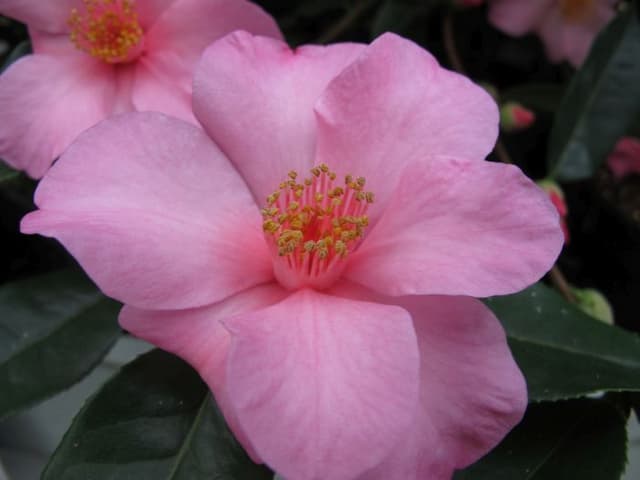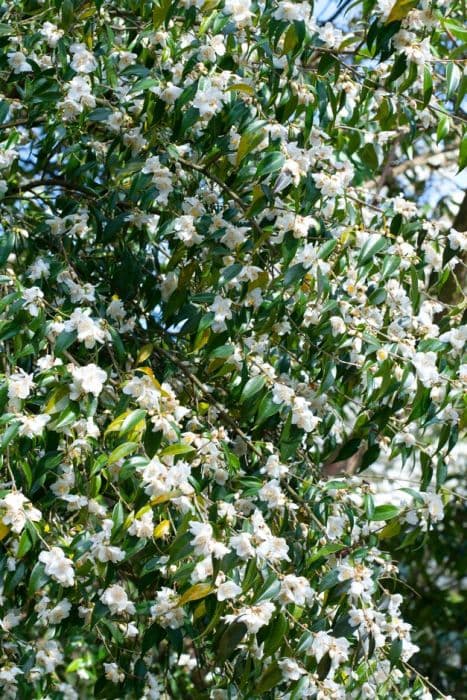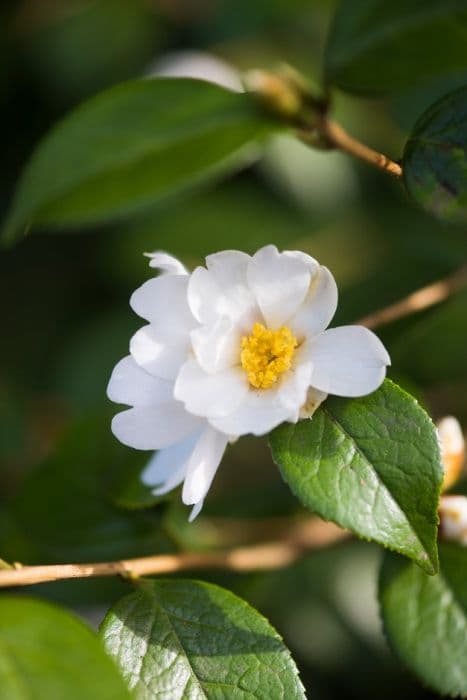Japanese Camellia Camellia japonica 'Annie Wylam'

ABOUT
Camellia japonica 'Annie Wylam' is a type of camellia with distinct characteristics that contribute to its ornamental beauty. This variety is known for its striking flowers, which bloom in a vibrant shade of pink. The flowers exhibit a formal double form, meaning the petals are arranged in a symmetrical, layered pattern that resembles a classic rose flower. The blooms are sizable and have a lush, full look. The leaves of 'Annie Wylam' are dark green, glossy, and leathery, providing a perfect backdrop for the showy flowers. They help to highlight the vividness of the blooms and add to the plant's overall lush appearance. This camellia variety, while remarkable in its aesthetic, is not just limited to its flowers and foliage. The overall structure, with its growth habit and branching pattern, contributes to its beauty, creating an appealing silhouette in the garden. The branches may display the blooms prominently, adding to the plant's striking appearance throughout its blooming season.
About this plant
 Names
NamesFamily
Theaceae.
Synonyms
Japanese Camellia, Common Camellia, Japonica.
Common names
Camellia japonica 'Annie Wylam'.
 Toxicity
ToxicityTo humans
The Camellia japonica, also known as the Japanese camellia, is not known to be toxic to humans. However, as with any plant material, it is possible for some individuals to experience stomach upset or an allergic reaction if ingested or if they come into prolonged contact with the leaves or blooms. There is no widely reported case of poisoning from this plant, suggesting that it is generally considered safe in terms of human interaction.
To pets
Camellia japonica, commonly known as the Japanese camellia, is also not typically considered toxic to pets. While it is always best to prevent pets from ingesting plant material, as it can sometimes lead to gastrointestinal upset (such as vomiting or diarrhea), there are no significant toxins in this plant that are known to cause serious harm or poisoning symptoms in pets upon ingestion.
 Characteristics
CharacteristicsLife cycle
Perennials
Foliage type
Evergreen
Color of leaves
Green
Flower color
Pink
Height
6-10 feet (1.8-3 meters)
Spread
5-7 feet (1.5-2.1 meters)
Plant type
Shrub
Hardiness zones
7
Native area
Japan
Benefits
 General Benefits
General Benefits- Aesthetic Appeal: Camellia japonica 'Annie Wylam' features beautiful large flowers which enhance the visual appeal of gardens.
- Year-Round Interest: This plant offers evergreen foliage, providing color and interest in the landscape throughout all seasons.
- Wildlife Attraction: The flowers can attract pollinators like bees, contributing to the local ecosystem's health.
- Versatility in Landscaping: It can be used for various landscape applications including hedges, foundation plantings, or as specimen plants.
- Shade Tolerance: It is capable of thriving in partial shade, making it suitable for gardens with variable light conditions.
- Drought Resistance: Once established, it can withstand periods of dryness, reducing the need for constant watering.
- Privacy and Screening: Its dense growth habit makes it suitable for privacy hedges or screens in the garden.
 Medical Properties
Medical PropertiesThis plant is not used for medical purposes.
 Air-purifying Qualities
Air-purifying QualitiesThis plant is not specifically known for air purifying qualities.
 Other Uses
Other Uses- Camellia petal dye: The petals of the Camellia japonica can be used to create natural dyes for fabrics, imparting soft colors when properly processed.
- Gourmet salads: Edible Camellia flowers can be added to gourmet salads for an unusual decorative touch and a mild taste.
- Camellia flower ice cubes: Freeze the petals in ice cubes to add a floral touch to drinks and cocktails.
- Botanical art: Pressed Camellia flowers can be used in decorative botanical artwork or in creating unique pieces of jewelry.
- Culinary decoration: Fresh or candied Camellia flowers can be used to decorate cakes and desserts.
- Flower arranging: Camellia blooms are a popular choice for ikebana, the Japanese art of flower arranging.
- Natural confetti: Dried and crumbled Camellia petals can serve as biodegradable confetti for weddings and celebrations.
- Handmade paper: Incorporating Camellia petals into handmade paper can give it a unique texture and appearance.
- Bath soak: Camellia petals can be included in a warm bath for a luxurious, aromatic experience.
- Photography subjects: The vivid blooms of Camellia japonica are excellent subjects for macro and nature photography due to their intricate details and vibrant colors.
Interesting Facts
 Feng Shui
Feng ShuiCamellia is not used in Feng Shui practice.
 Zodiac Sign Compitability
Zodiac Sign CompitabilityCamellia is not used in astrology practice.
 Plant Symbolism
Plant Symbolism- Love: In many cultures, Camellia japonica, commonly known as the Japanese camellia, symbolizes love and affection. Its lush, full blooms and romantic appearance make it a favorite for expressing romantic intentions.
- Admiration: The camellia is often given as a gift to show admiration for someone's beauty or accomplishments, as its own beauty and perfection are widely admired.
- Perfection: The perfection of the camellia's petals represents the ideal of perfection in many societies. It is sometimes given to convey the message that someone is perfect in the eyes of the giver.
- Longevity and Faithfulness: The sturdy nature of the camellia, which allows it to thrive in various conditions, is symbolic of both longevity and faithfulness in relationships.
- Devotion: Because camellias bloom reliably every year, they have become a symbol of devotion and steadfastness, suggesting the enduring nature of one's feelings.
 Water
WaterCamellia japonica, commonly known as the Japanese camellia, prefers consistently moist soil, so water when the top inch of soil feels dry to the touch. Generally, this means watering once a week, but this may vary based on climate, season, and weather conditions. Use roughly 1 gallon of water for each watering session to ensure deep soil saturation. During hot, dry periods, the plant might need more frequent watering. In contrast, reduce watering during the dormant winter months to prevent waterlogging.
 Light
LightJapanese camellia thrives in partial shade, enjoying bright, indirect light. It should be protected from intense afternoon sun to avoid leaf scorch. The ideal spot for this plant would be in an area that gets filtered morning sunlight with dappled shade in the afternoon, such as a location under the canopy of taller trees or on the north side of a building.
 Temperature
TemperatureJapanese camellias prefer temperatures between 70°F and 85°F for optimal growth. They can tolerate minimum temperatures down to around 20°F but should be protected from cold winds and frost to prevent damage to flower buds and leaves. Ideal conditions are cool to moderate, maintaining a steady temperature away from dramatic fluctuations.
 Pruning
PruningThe Japanese camellia should be pruned to maintain shape, remove dead or weak growth, and encourage airflow within the canopy. Pruning is best done after blooming has finished but before new growth starts, typically in late winter or early spring. Thin out crowded branches and selectively prune to shape the plant, focusing on maintaining an open center for sunlight penetration and air circulation.
 Cleaning
CleaningAs needed
 Soil
SoilCamellia, commonly known as Japanese Camellia, thrives in well-draining, acidic soil with a pH of 5.5 to 6.5. The best soil mix is a blend of 50% peat moss or acidic compost, 30% pine bark, and 20% perlite or sand for aeration. Mulching with pine needles can help maintain acidity and moisture.
 Repotting
RepottingJapanese Camellia should be repotted every 2-3 years to refresh the soil and avoid root-bound conditions. Early spring, just before the growing season starts, is the best time for repotting these evergreen shrubs.
 Humidity & Misting
Humidity & MistingJapanese Camellia prefers high humidity levels, around 50-60%, which is ideal for maintaining healthy growth and lush foliage. They benefit from regular misting if grown in a dry indoor environment.
 Suitable locations
Suitable locationsIndoor
Place in bright, indirect light; maintain high humidity.
Outdoor
Plant in partial shade; shelter from strong winds and frost.
Hardiness zone
7-9 USDA
 Life cycle
Life cycleCamellia japonica 'Annie Wylam', commonly known as Japanese camellia, begins its life cycle with seed germination, which requires a period of stratification to break dormancy. Following germination, the seedling stage involves initial root and shoot development, with the plant gradually establishing a leaf canopy. Vegetative growth continues as the plant matures, with the development of sturdy branches and evergreen foliage. The maturity stage is marked by the plant's ability to reproduce; the Japanese camellia typically begins flowering from late winter to spring, producing showy blossoms that attract pollinators such as bees. After pollination, the plant develops fruit, known as a capsule, which contains seeds that are eventually dispersed, potentially giving rise to new plants. The plant continues to go through annual cycles of growth and reproduction, with a life span that can extend over many decades if cultivated in favorable conditions.
 Propogation
PropogationPropogation time
Spring to Summer
Propogation: Camellia japonica 'Annie Wylam', commonly known as the Japanese camellia, is typically propagated through semi-hardwood cuttings. This method is commonly carried out in late summer, after the plant has completed the bulk of its seasonal growth. To do so, a healthy, semi-hardwood branch of about 4 to 6 inches long is selected, making sure that it has several leaves but the flowers or flower buds are removed. The cutting is then dipped in rooting hormone to encourage root growth. Afterwards, it's planted in a well-draining potting mix or a mixture of peat and perlite. The cutting should be kept in a warm environment with indirect light and consistent humidity, which can be achieved by covering it with a plastic bag or placing it in a propagator. Roots typically develop within a few weeks, after which the new plant can gradually acclimatize to less controlled conditions before being transplanted outdoors.









